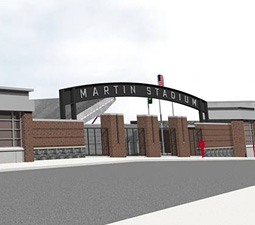In 1978, Sam Jankovich knew something had to be done about the football stadium.
With just 27,600 seats, Martin Stadium was much smaller than its counterparts in the Pacific-10 Conference. Because of a Pac-10 rule requiring guarantees of $25,000 to visiting teams, the Cougars had to truck up to Spokane to play certain opponents, namely USC, UCLA, and Washington, at the larger Joe Albi Stadium.
“If you could not bring in USC, UCLA, and Washington to Pullman, you could not bring the biggest attractions to where you get the biggest crowds,” said WSU’s former athletic director this spring when he stopped by Bohler Athletic Complex for a visit and the opportunity to mull over the latest stadium renovation.
Back in the late ’70s, Jankovich reasoned that with their games in Pullman, the Cougars could be much more competitive.
The solution in his eyes was simple—expand the stadium to a capacity larger than Joe Albi’s. It would address the issues of competitiveness and revenue and potentially avoid the problem of WSU losing a place in the Pac-10 if it didn’t keep up with rest of the group.
“If you’re not competitive, then you are not going to raise money, and you are not going to sell tickets,” said Jankovich. “That, in turn, would affect the conference affiliation.”
So he decided to push to expand the stadium. “I felt we had no other choice,” he said.
Three decades later, Jim Sterk, WSU’s current director of athletics, knows the feeling. That’s why he pushed for the first part of a renovation, which includes new bathrooms and improved concession area that game-goers will see this season. And it’s why he’s seeking $42 million more for adding more seats and premium seating in Phase III, which he hopes will be underway in 2009.
For Sterk, it’s a matter of ensuring that WSU’s Pac-10 standing stays secure.
The Pac-10 Conference was born out of the Pacific Coast Conference, an entity formed by four west coast schools in 1916 and joined by Washington State the following year. In 1959, the organization was replaced by the Athletic Association of Western Universities, later named Pacific-8. That became the Pac-10 in 1978 when the University of Arizona and Arizona State joined the group.
It’s a group of schools for whom football is an all-important tool for recruiting new students, connecting with alumni and donors, and putting their campuses on televisions in the homes of millions around the country.
The competitiveness Jankovich was seeking in this elite conference became evident with eight trips to bowl games by the program since the stadium expansion.
But while the Cougars were competitive with their Pac-10 counterparts, the venue they played in was not. When Sterk arrived at WSU in 2000, around the same time as President V. Lane Rawlins, he and the president noted that, in comparison the rest of the conference competitors, Martin Stadium was not up to Pac-10 standards. Portions of it were contained by chain link fence, and through the fence you could see portable toilets, which were necessary to bring the number of restrooms up to a sufficient level.
The president, who along with Sterk had seen much better facilities at the away games, didn’t need much persuading to agree improvements were needed. Often the football stadium is the front door of the institution, says Sterk. WSU’s is even more so since it is situated at the center of campus.
Jankovich feels the same. “If you are going to have an athletic program, and especially a big-time football program, it is the responsibility of the program to bring the fans, the family, the alumni, the friends back to the campus.”
However, in the collegiate athletics of the 21st century, competitiveness is measured not only on the field but also in the financial arena, and the revenue generated by WSU has not kept pace with the other programs in the Pac-10.
The University’s athletic budget in 2007 was about $24 million below the conference average. The next lowest, Oregon State, had $16 million more. Just three years earlier, the disparity between the two schools was just over $3 million.
In the intervening period, OSU’s stadium underwent a renovation that added nearly 8,000 seats including premium seating. Furthermore, Stanford and University of Oregon have recently undergone stadium renovations of their own, which included the addition of premium seating as well.
While these Pac-10 schools have renovated their stadiums, Martin Stadium has stayed relatively the same since the 1979 renovation. Its seating capacity during the 2007 season was 35,117, the smallest of any Pac-10 school.
Sterk and Jankovich agree the significance of Pac-10 membership extends beyond the athletic arena. “Our affiliation in the Pac-10 Conference elevates the level and prestige of a graduate’s degree,” Sterk says. “I think that is very important. That’s something to cherish and something we never want to lose.”
The support Rawlins gave the project has continued under President Elson S. Floyd, who succeeded Rawlins in May 2007. “The stadium renovation is critical to strengthening the ties among members of the Cougar family as the University rededicates itself to meeting the priorities of the 21st century,” says Floyd. “In addition, a renovated stadium will reinvigorate our ability to recruit top student-athletes and coaches, strengthening our ability to compete in the Pac-10 and enhancing our overall institutional reputation.”
Phase III encompasses the addition of premium seating, including luxury suites, loge and club seats atop the north stands for a total of approximately 2,200 additional seats. The revenue from the additional seats will nearly be equal to what is produced by current ticket sales, says Sterk. “We generate about $4 million in ticket sales for a season. With this renovation, and our sales of those premium seats, we could generate close to that figure just with that small amount of seating.”


